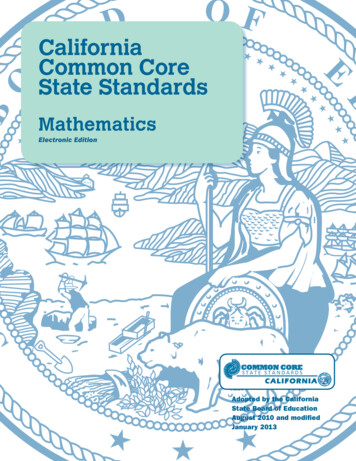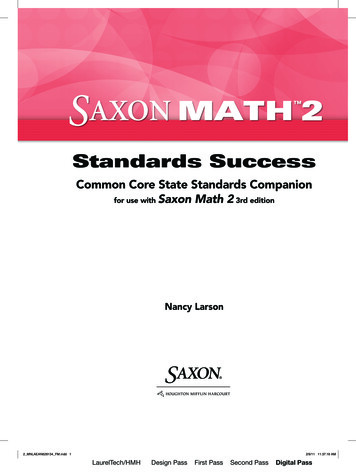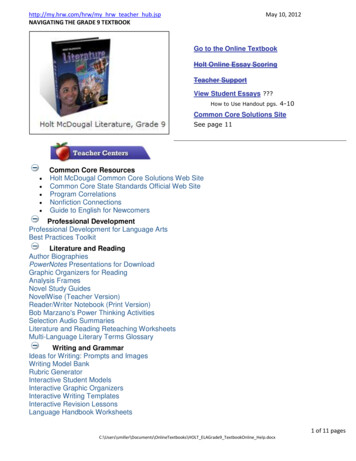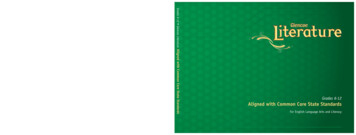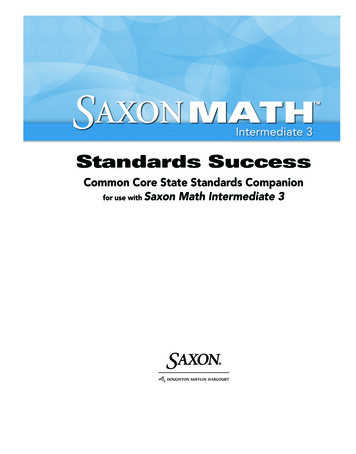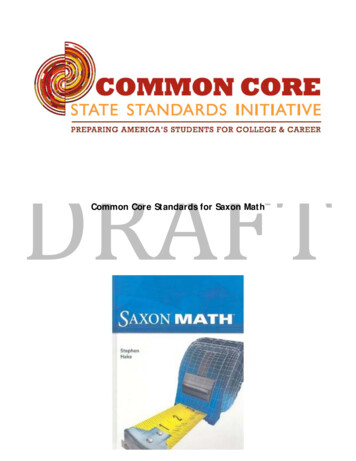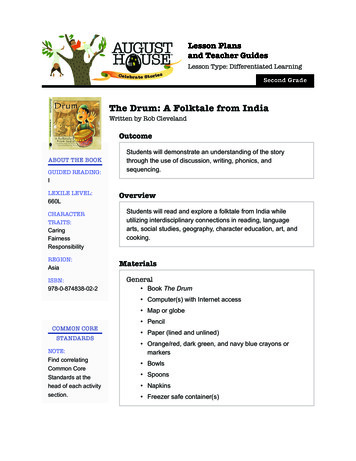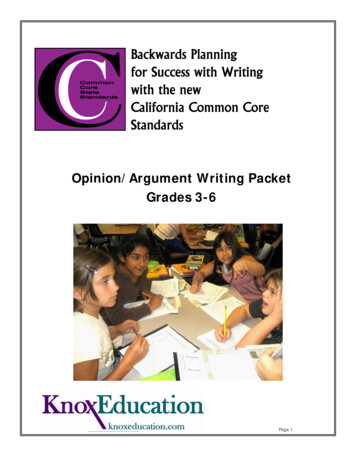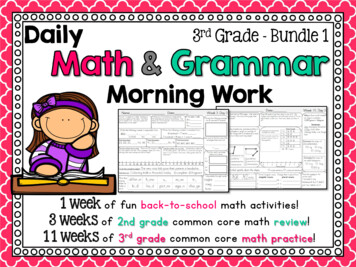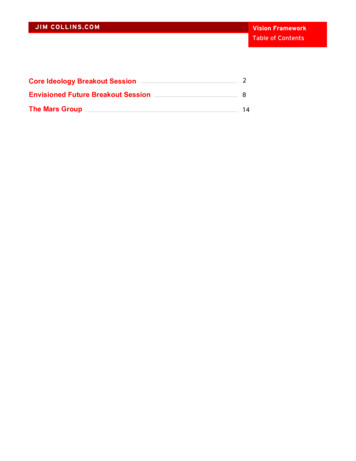
Transcription
Common CoreState StandardsforMathematics
Common Core State Standards for MATHEMATICSTable of ContentsIntroduction3Standards for Mathematical Practice6Standards for Mathematical ContentKindergartenGrade 1Grade 2Grade 3Grade 4Grade 5Grade 6Grade 7Grade 891317212733394652High School — IntroductionHigh School — Statistics and Probability586267727479GlossarySample of Works Consulted8591High School — Number and QuantityHigh School — AlgebraHigh School — FunctionsHigh School — ModelingHigh School — Geometry
Common Core State Standards for MATHEMATICSIntroductionToward greater focus and coherenceMathematics experiences in early childhood settings should concentrate on(1) number (which includes whole number, operations, and relations) and (2)geometry, spatial relations, and measurement, with more mathematics learningtime devoted to number than to other topics. Mathematical process goalsshould be integrated in these content areas. — Mathematics Learning in Early Childhood, National Research Council, 2009The composite standards [of Hong Kong, Korea and Singapore] have a numberof features that can inform an international benchmarking process for thedevelopment of K–6 mathematics standards in the U.S. First, the compositestandards concentrate the early learning of mathematics on the number,measurement, and geometry strands with less emphasis on data analysis andlittle exposure to algebra. The Hong Kong standards for grades 1–3 devoteapproximately half the targeted time to numbers and almost all the timeremaining to geometry and measurement.— Ginsburg, Leinwand and Decker, 2009Because the mathematics concepts in [U.S.] textbooks are often weak, thepresentation becomes more mechanical than is ideal. We looked at bothtraditional and non-traditional textbooks used in the US and found thisconceptual weakness in both.— Ginsburg et al., 2005There are many ways to organize curricula. The challenge, now rarely met, is toavoid those that distort mathematics and turn off students.— Steen, 2007For over a decade, research studies of mathematics education in high-performingcountries have pointed to the conclusion that the mathematics curriculum in theUnited States must become substantially more focused and coherent in order toimprove mathematics achievement in this country. To deliver on the promise ofcommon standards, the standards must address the problem of a curriculum thatis “a mile wide and an inch deep.” These Standards are a substantial answer to thatchallenge.It is important to recognize that “fewer standards” are no substitute for focusedstandards. Achieving “fewer standards” would be easy to do by resorting to broad,general statements. Instead, these Standards aim for clarity and specificity.Assessing the coherence of a set of standards is more difficult than assessingtheir focus. William Schmidt and Richard Houang (2002) have said that contentstandards and curricula are coherent if they are:INTRODUCTION articulated over time as a sequence of topics and performances that arelogical and reflect, where appropriate, the sequential or hierarchical natureof the disciplinary content from which the subject matter derives. That is,what and how students are taught should reflect not only the topics that fallwithin a certain academic discipline, but also the key ideas that determinehow knowledge is organized and generated within that discipline. This implies3
Common Core State Standards for MATHEMATICSthat to be coherent, a set of content standards must evolve from particulars(e.g., the meaning and operations of whole numbers, including simple mathfacts and routine computational procedures associated with whole numbersand fractions) to deeper structures inherent in the discipline. These deeperstructures then serve as a means for connecting the particulars (such as anunderstanding of the rational number system and its properties). (emphasisadded)These Standards endeavor to follow such a design, not only by stressing conceptualunderstanding of key ideas, but also by continually returning to organizingprinciples such as place value or the properties of operations to structure thoseideas.In addition, the “sequence of topics and performances” that is outlined in a body ofmathematics standards must also respect what is known about how students learn.As Confrey (2007) points out, developing “sequenced obstacles and challengesfor students absent the insights about meaning that derive from careful study oflearning, would be unfortunate and unwise.” In recognition of this, the developmentof these Standards began with research-based learning progressions detailingwhat is known today about how students’ mathematical knowledge, skill, andunderstanding develop over time.Understanding mathematicsThese Standards define what students should understand and be able to do intheir study of mathematics. Asking a student to understand something meansasking a teacher to assess whether the student has understood it. But what doesmathematical understanding look like? One hallmark of mathematical understandingis the ability to justify, in a way appropriate to the student’s mathematical maturity,why a particular mathematical statement is true or where a mathematical rulecomes from. There is a world of difference between a student who can summon amnemonic device to expand a product such as (a b)(x y) and a student whocan explain where the mnemonic comes from. The student who can explain the ruleunderstands the mathematics, and may have a better chance to succeed at a lessfamiliar task such as expanding (a b c)(x y). Mathematical understanding andprocedural skill are equally important, and both are assessable using mathematicaltasks of sufficient richness.The Standards begin on page 6 with eight Standards for Mathematical Practice.INTRODUCTION The Standards set grade-specific standards but do not define the interventionmethods or materials necessary to support students who are well below or wellabove grade-level expectations. It is also beyond the scope of the Standards todefine the full range of supports appropriate for English language learners andfor students with special needs. At the same time, all students must have theopportunity to learn and meet the same high standards if they are to access theknowledge and skills necessary in their post-school lives. The Standards shouldbe read as allowing for the widest possible range of students to participate fullyfrom the outset, along with appropriate accommodations to ensure maximumparticipaton of students with special education needs. For example, for studentswith disabilities reading should allow for use of Braille, screen reader technology, orother assistive devices, while writing should include the use of a scribe, computer,or speech-to-text technology. In a similar vein, speaking and listening should beinterpreted broadly to include sign language. No set of grade-specific standardscan fully reflect the great variety in abilities, needs, learning rates, and achievementlevels of students in any given classroom. However, the Standards do provide clearsignposts along the way to the goal of college and career readiness for all students.4
Common Core State Standards for MATHEMATICSHow to read the grade level standardsStandards define what students should understand and be able to do.Clusters are groups of related standards. Note that standards from different clustersmay sometimes be closely related, because mathematicsis a connected subject.Domains are larger groups of related standards. Standards from different domainsmay sometimes be closely related.DomainNumber and Operations in Base Ten3.NBTUse place value understanding and properties of operations toperform multi-digit arithmetic.1.StandardUse place value understanding to round whole numbers to the nearest10 or 100.2. Fluently add and subtract within 1000 using strategies and algorithmsbased on place value, properties of operations, and/or the relationshipbetween addition and subtraction.Cluster3. Multiply one-digit whole numbers by multiples of 10 in the range10-90 (e.g., 9 80, 5 60) using strategies based on place value andproperties of operations.These Standards do not dictate curriculum or teaching methods. For example, justbecause topic A appears before topic B in the standards for a given grade, it doesnot necessarily mean that topic A must be taught before topic B. A teacher mightprefer to teach topic B before topic A, or might choose to highlight connections byteaching topic A and topic B at the same time. Or, a teacher might prefer to teach atopic of his or her own choosing that leads, as a byproduct, to students reaching thestandards for topics A and B.What students can learn at any particular grade level depends upon what theyhave learned before. Ideally then, each standard in this document might have beenphrased in the form, “Students who already know . should next come to learn .”But at present this approach is unrealistic—not least because existing educationresearch cannot specify all such learning pathways. Of necessity therefore,grade placements for specific topics have been made on the basis of state andinternational comparisons and the collective experience and collective professionaljudgment of educators, researchers and mathematicians. One promise of commonstate standards is that over time they will allow research on learning progressionsto inform and improve the design of standards to a much greater extent than ispossible today. Learning opportunities will continue to vary across schools andschool systems, and educators should make every effort to meet the needs ofindividual students based on their current understanding.INTRODUCTION These Standards are not intended to be new names for old ways of doing business.They are a call to take the next step. It is time for states to work together to buildon lessons learned from two decades of standards based reforms. It is time torecognize that standards are not just promises to our children, but promises weintend to keep.5
Common Core State Standards for MATHEMATICSMathematics Standardsfor Mathematical PracticeThe Standards for Mathematical Practice describe varieties of expertise thatmathematics educators at all levels should seek to develop in their students.These practices rest on important “processes and proficiencies” with longstandingimportance in mathematics education. The first of these are the NCTM processstandards of problem solving, reasoning and proof, communication, representation,and connections. The second are the strands of mathematical proficiency specifiedin the National Research Council’s report Adding It Up: adaptive reasoning, strategiccompetence, conceptual understanding (comprehension of mathematical concepts,operations and relations), procedural fluency (skill in carrying out proceduresflexibly, accurately, efficiently and appropriately), and productive disposition(habitual inclination to see mathematics as sensible, useful, and worthwhile, coupledwith a belief in diligence and one’s own efficacy).1 Make sense of problems and persevere in solving them.Mathematically proficient students start by explaining to themselves the meaningof a problem and looking for entry points to its solution. They analyze givens,constraints, relationships, and goals. They make conjectures about the form andmeaning of the solution and plan a solution pathway rather than simply jumping intoa solution attempt. They consider analogous problems, and try special cases andsimpler forms of the original problem in order to gain insight into its solution. Theymonitor and evaluate their progress and change course if necessary. Older studentsmight, depending on the context of the problem, transform algebraic expressions orchange the viewing window on their graphing calculator to get the information theyneed. Mathematically proficient students can explain correspondences betweenequations, verbal descriptions, tables, and graphs or draw diagrams of importantfeatures and relationships, graph data, and search for regularity or trends. Youngerstudents might rely on using concrete objects or pictures to help conceptualizeand solve a problem. Mathematically proficient students check their answers toproblems using a different method, and they continually ask themselves, “Does thismake sense?” They can understand the approaches of others to solving complexproblems and identify correspondences between different approaches.2 Reason abstractly and quantitatively.3 Construct viable arguments and critique the reasoning of others.Mathematically proficient students understand and use stated assumptions,definitions, and previously established results in constructing arguments. Theymake conjectures and build a logical progression of statements to explore thetruth of their conjectures. They are able to analyze situations by breaking them intocases, and can recognize and use counterexamples. They justify their conclusions,standards for mathematical practice Mathematically proficient students make sense of quantities and their relationshipsin problem situations. They bring two complementary abilities to bear on problemsinvolving quantitative relationships: the ability to decontextualize—to abstracta given situation and represent it symbolically and manipulate the representingsymbols as if they have a life of their own, without necessarily attending totheir referents—and the ability to contextualize, to pause as needed during themanipulation process in order to probe into the referents for the symbols involved.Quantitative reasoning entails habits of creating a coherent representation ofthe problem at hand; considering the units involved; attending to the meaning ofquantities, not just how to compute them; and knowing and flexibly using differentproperties of operations and objects.6
Common Core State Standards for MATHEMATICScommunicate them to others, and respond to the arguments of others. They reasoninductively about data, making plausible arguments that take into account thecontext from which the data arose. Mathematically proficient students are also ableto compare the effectiveness of two plausible arguments, distinguish correct logic orreasoning from that which is flawed, and—if there is a flaw in an argument—explainwhat it is. Elementary students can construct arguments using concrete referentssuch as objects, drawings, diagrams, and actions. Such arguments can make senseand be correct, even though they are not generalized or made formal until latergrades. Later, students learn to determine domains to which an argument applies.Students at all grades can listen or read the arguments of others, decide whetherthey make sense, and ask useful questions to clarify or improve the arguments.4 Model with mathematics.Mathematically proficient students can apply the mathematics they know to solveproblems arising in everyday life, society, and the workplace. In early grades, this mightbe as simple as writing an addition equation to describe a situation. In middle grades,a student might apply proportional reasoning to plan a school event or analyze aproblem in the community. By high school, a student might use geometry to solve adesign problem or use a function to describe how one quantity of interest dependson another. Mathematically proficient students who can apply what they know arecomfortable making assumptions and approximations to simplify a complicatedsituation, realizing that these may need revision later. They are able to identifyimportant quantities in a practical situation and map their relationships using suchtools as diagrams, two-way tables, graphs, flowcharts and formulas. They can analyzethose relationships mathematically to draw conclusions. They routinely interpret theirmathematical results in the context of the situation and reflect on whether the resultsmake sense, possibly improving the model if it has not served its purpose.5 Use appropriate tools strategically.6 Attend to precision.Mathematically proficient students try to communicate precisely to others. Theytry to use clear definitions in discussion with others and in their own reasoning.They state the meaning of the symbols they choose, including using the equal signconsistently and appropriately. They are careful about specifying units of measure,and labeling axes to clarify the correspondence with quantities in a problem. Theycalculate accurately and efficiently, express numerical answers with a degree ofprecision appropriate for the problem context. In the elementary grades, studentsgive carefully formulated explanations to each other. By the time they reach highschool they have learned to examine claims and make explicit use of definitions.standards for mathematical practice Mathematically proficient students consider the available tools when solving amathematical problem. These tools might include pencil and paper, concretemodels, a ruler, a protractor, a calculator, a spreadsheet, a computer algebra system,a statistical package, or dynamic geometry software. Proficient students aresufficiently familiar with tools appropriate for their grade or course to make sounddecisions about when each of these tools might be helpful, recognizing both theinsight to be gained and their limitations. For example, mathematically proficienthigh school students analyze graphs of functions and solutions generated using agraphing calculator. They detect possible errors by strategically using estimationand other mathematical knowledge. When making mathematical models, they knowthat technology can enable them to visualize the results of varying assumptions,explore consequences, and compare predictions with data. Mathematicallyproficient students at various grade levels are able to identify relevant externalmathematical resources, such as digital content located on a website, and use themto pose or solve problems. They are able to use technological tools to explore anddeepen their understanding of concepts.7
Common Core State Standards for MATHEMATICS7 Look for and make use of structure.Mathematically proficient students look closely to discern a pattern or structure.Young students, for example, might notice that three and seven more is the sameamount as seven and three more, or they may sort a collection of shapes accordingto how many sides the shapes have. Later, students will see 7 8 equals thewell remembered 7 5 7 3, in preparation for learning about the distributiveproperty. In the expression x2 9x 14, older students can see the 14 as 2 7 andthe 9 as 2 7. They recognize the significance of an existing line in a geometricfigure and can use the strategy of drawing an auxiliary line for solving problems.They also can step back for an overview and shift perspective. They can seecomplicated things, such as some algebraic expressions, as single objects or asbeing composed of several objects. For example, they can see 5 – 3(x – y)2 as 5minus a positive number times a square and use that to realize that its value cannotbe more than 5 for any real numbers x and y.8 Look for and express regularity in repeated reasoning.Mathematically proficient students notice if calculations are repeated, and lookboth for general methods and for shortcuts. Upper elementary students mightnotice when dividing 25 by 11 that they are repeating the same calculations overand over again, and conclude they have a repeating decimal. By paying attentionto the calculation of slope as they repeatedly check whether points are on the linethrough (1, 2) with slope 3, middle school students might abstract the equation(y – 2)/(x – 1) 3. Noticing the regularity in the way terms cancel when expanding(x – 1)(x 1), (x – 1)(x2 x 1), and (x – 1)(x3 x2 x 1) might lead them to thegeneral formula for the sum of a geometric series. As they work to solve a problem,mathematically proficient students maintain oversight of the process, whileattending to the details. They continually evaluate the reasonableness of theirintermediate results.Connecting the Standards for Mathematical Practice to the Standards forMathematical ContentThe Standards for Mathematical Practice describe ways in which developing studentpractitioners of the discipline of mathematics increasingly ought to engage withthe subject matter as they grow in mathematical maturity and expertise throughoutthe elementary, middle and high school years. Designers of curricula, assessments,and professional development should all attend to the need to connect themathematical practices to mathematical content in mathematics instruction.In this respect, those content standards which set an expectation of understandingare potential “points of intersection” between the Standards for MathematicalContent and the Standards for Mathematical Practice. These points of intersectionare intended to be weighted toward central and generative concepts in theschool mathematics curriculum that most merit the time, resources, innovativeenergies, and focus necessary to qualitatively improve the curriculum, instruction,assessment, professional development, and student achievement in mathematics.standards for mathematical practice The Standards for Mathematical Content are a balanced combination of procedureand understanding. Expectations that begin with the word “understand” are oftenespecially good opportunities to connect the practices to the content. Studentswho lack understanding of a topic may rely on procedures too heavily. Withouta flexible base from which to work, they may be less likely to consider analogousproblems, represent problems coherently, justify conclusions, apply the mathematicsto practical situations, use technology mindfully to work with the mathematics,explain the mathematics accurately to other students, step back for an overview, ordeviate from a known procedure to find a shortcut. In short, a lack of understandingeffectively prevents a student from engaging in the mathematical practices.8
Common Core State Standards for MATHEMATICSMathematics KindergartenIn Kindergarten, instructional time should focus on two critical areas: (1)representing, relating, and operating on whole numbers, initially withsets of objects; (2) describing shapes and space. More learning time inKindergarten should be devoted to number than to other topics.(1) Students use numbers, including written numerals, to representquantities and to solve quantitative problems, such as counting objects ina set; counting out a given number of objects; comparing sets or numerals;and modeling simple joining and separating situations with sets of objects,or eventually with equations such as 5 2 7 and 7 – 2 5. (Kindergartenstudents should see addition and subtraction equations, and studentwriting of equations in kindergarten is encouraged, but it is not required.)Students choose, combine, and apply effective strategies for answeringquantitative questions, including quickly recognizing the cardinalities ofsmall sets of objects, counting and producing sets of given sizes, countingthe number of objects in combined sets, or counting the number of objectsthat remain in a set after some are taken away.(2) Students describe their physical world using geometric ideas (e.g.,shape, orientation, spatial relations) and vocabulary. They identify, name,and describe basic two-dimensional shapes, such as squares, triangles,circles, rectangles, and hexagons, presented in a variety of ways (e.g., withdifferent sizes and orientations), as well as three-dimensional shapes suchas cubes, cones, cylinders, and spheres. They use basic shapes and spatialreasoning to model objects in their environment and to construct morecomplex shapes.KINDERGARTEN 9
Common Core State Standards for MATHEMATICSGrade K OverviewCounting and CardinalityMathematical Practices Know number names and the count sequence.1.Make sense of problems and persevere insolving them.2.Reason abstractly and quantitatively.3.Construct viable arguments and critiquethe reasoning of others.4.Model with mathematics.5.Use appropriate tools strategically.6.Attend to precision.7.Look for and make use of structure.8.Look for and express regularity in repeatedreasoning. Count to tell the number of objects. Compare numbers.Operations and Algebraic Thinking Understand addition as putting together andadding to, and understand subtraction astaking apart and taking from.Number and Operations in Base Ten Work with numbers 11–19 to gain foundationsfor place value.Measurement and Data Describe and compare measurable attributes. Classify objects and count the number ofobjects in categories.Geometry Identify and describe shapes. Analyze, compare, create, and composeshapes.KINDERGARTEN 10
Common Core State Standards for MATHEMATICSCounting and CardinalityK.CCKnow number names and the count sequence.1.Count to 100 by ones and by tens.2. Count forward beginning from a given number within the knownsequence (instead of having to begin at 1).3. Write numbers from 0 to 20. Represent a number of objects with awritten numeral 0-20 (with 0 representing a count of no objects).Count to tell the number of objects.4. Understand the relationship between numbers and quantities; connectcounting to cardinality.a.When counting objects, say the number names in the standardorder, pairing each object with one and only one number nameand each number name with one and only one object.b.Understand that the last number name said tells the number ofobjects counted. The number of objects is the same regardless oftheir arrangement or the order in which they were counted.c.Understand that each successive number name refers to a quantitythat is one larger.5. Count to answer “how many?” questions about as many as 20 thingsarranged in a line, a rectangular array, or a circle, or as many as 10things in a scattered configuration; given a number from 1–20, countout that many objects.Compare numbers.6. Identify whether the number of objects in one group is greater than,less than, or equal to the number of objects in another group, e.g., byusing matching and counting strategies.17.Compare two numbers between 1 and 10 presented as writtennumerals.Operations and Algebraic ThinkingK.OAUnderstand addition as putting together and adding to, and understand subtraction as taking apart and taking from.1.Represent addition and subtraction with objects, fingers, mentalimages, drawings2, sounds (e.g., claps), acting out situations, verbalexplanations, expressions, or equations.2. Solve addition and subtraction word problems, and add and subtractwithin 10, e.g., by using objects or drawings to represent the problem.3. Decompose numbers less than or equal to 10 into pairs in morethan one way, e.g., by using objects or drawings, and record eachdecomposition by a drawing or equation (e.g., 5 2 3 and 5 4 1).4. For any number from 1 to 9, find the number that makes 10 whenadded to the given number, e.g., by using objects or drawings, andrecord the answer with a drawing or equation.5. Fluently add and subtract within 5.Include groups with up to ten objects.Drawings need not show details, but should show the mathematics in the problem.(This applies wherever drawings are mentioned in the Standards.)12KINDERGARTEN 11
Common Core State Standards for MATHEMATICSNumber and Operations in Base TenK.NBTWork with numbers 11–19 to gain foundations for place value.1.Compose and decompose numbers from 11 to 19 into ten ones andsome further ones, e.g., by using objects or drawings, and record eachcomposition or decomposition by a drawing or equation (e.g., 18 10 8); understand that these numbers are composed of ten ones and one,two, three, four, five, six, seven, eight, or nine ones.Measurement and DataK.MDDescribe and compare measurable attributes.1.Describe measurable attributes of objects, such as length or weight.Describe several measurable attributes of a single object.2. Directly compare two objects with a measurable attribute in common,to see which object has “more of”/“less of” the attribute, and describethe difference. For example, directly compare the heights of twochildren and describe one child as taller/shorter.Classify objects and count the number of objects in each category.3. Classify objects into given categories; count the numbers of objects ineach category and sort the categories by count.3GeometryK.GIdentify and describe shapes (squares, circles, triangles, rectangles,hexagons, cubes, cones, cylinders, and spheres).1.Describe objects in the environment using names of shapes, anddescribe the relative positions of these objects using terms such asabove, below, beside, in front of, behind, and next to.2. Correctly name shapes regardless of their orientations or overall size.3. Identify shapes as two-dimensional (lying in a plane, “flat”) or threedimensional (“solid”).Analyze, compare, create, and compose shapes.4. Analyze and compare two- and three-dimensional shapes, indifferent sizes and orientations, using informal language to describetheir similarities, differences, parts (e.g., number of sides andvertices/“corners”) and other attributes (e.g., having sides of equallength).5. Model shapes in the world by building shapes from components (e.g.,sticks and clay balls) and drawing shapes.6. Compose simple shapes to form larger shapes. For example, “Can youjoin these two triangles with full sides touching to make a rectangle?”KINDERGARTEN Limit category counts to be less than or equal to 10.312
Common Core State Standards for MATHEMATICSMathematics Grade 1In Grade 1, instructional time should focus on four critical areas: (1)developing understanding of addition, subtraction, and strategies foraddition and subtraction within 20; (2) developing understanding of wholenumber relationships and place value, including grouping in tens andones; (3) developing understanding of linear measurement and measuringlengt
Grade 1 13 Grade 2 17 Grade 3 21 Grade 4 27 Grade 5 33 Grade 6 39 Grade 7 46 Grade 8 52 High School — Introduction High School — Number and Quantity 58 . including simple math facts and routine computational procedures associated with whole numbers and fractions) to d
